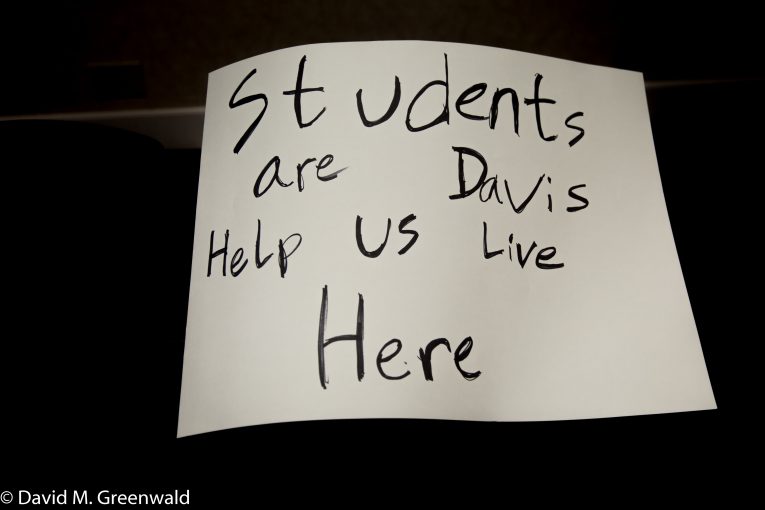
 by Don Gibson
by Don Gibson
For the past year or so, local elected and appointed officials have been asking for numbers that better illustrate the Davis housing crisis, especially as they relate to student housing and expected development on the UC Davis campus.
Since graduate students love surveys and statistics, we thought we would undertake an official effort to find these numbers. We recently completed a UC Davis housing survey with 1840 respondents and what we found was even more illustrative of a crisis than we expected, especially when you factor in pent up demand (i.e. “mini dorms”).
In short, if UC Davis builds everything it says it will, and if all projects that have been passed and are currently in the queue for debate and decision get built, we will still have a shortage of at least 1,200 beds by the 2022-2023 school year.
I’ve included a chart below that illustrates these numbers. Davis Live is the next student housing project up for City Council approval. I encourage the public to write and comment in support of  this project for several reasons beyond the fact that we desperately need beds. Those reasons are:
this project for several reasons beyond the fact that we desperately need beds. Those reasons are:
Social justice: 19% of UC Davis students report some form of homelessness or housing insecurity (couch surfing). As a middle-class university town, we can do better.
Location: This development will be built in a location that has always been dedicated to student housing. It would replace an old fraternity house.
Affordability: Davis Live will rent 15% of its beds at an affordable rate and subscribes to the recent ordinance which suggests that 5% of these beds be for extremely low income individuals, 5% be for very low income individuals, and 5% be for low income individuals.
Environmentally responsible: Davis Live will achieve LEED Gold standards and have a metering program with incentives for conservation. Its location is right across the street from campus which encourages students to leave their cars (and carbon footprint) behind.
Density: Davis Live will put over 400 student beds in a highly suitable location for student housing. It also provides five stories of student housing, which will hopefully challenge the university to also think higher than three to four stories.
Reducing Mini Dorms: Through our campus survey we have estimated that there are approximately 465 “mini dorms” (1.5.renter/bedroom in a detached house) with approximately 2,200 students living in them. To reduce impacts on family neighborhoods these students need more options.
Community benefit: Davis Live will activate Russell Blvd by making its entrance on the south side of the building. It has increased its setbacks to allow for a bike lane and the building design conforms to the character of the surrounding neighborhood.
Again, please urge your appointed Planning Commissioners and elected City Councilmembers to vote yes for Davis Live on July 25 and August 28 respectively.

Get Tickets To Vanguard’s Immigration Rights Event
While Russell Blvd and Mrak Hall diddle, Rome burns. And nobody cares.
Good graduate students don’t “expect” anything of their surveys. That is called “bias”.
A good graduate student who wants a career in higher education will learn early on that finding a way to get the results the people paying for the “survey” want is a good way to get more funding for “research” (that shows what the people paying for the “research” want) and eventually secure a full time tenured teaching position.
Ken A. — Your truth is actually more real than the truth I expressed. You win.
What does that mean? “Activate” Russell Blvd?
I’ve known Don Gibson for some time, and have found him to be well-informed and articulate. Not to be argumentative, but some of the comments critical of his article seem to be a little “picky.” Some of the verbiage used to describe the Davis Live project is actually taken from other documents, so Don should not be held responsible for them. His article, perhaps without even intending to do so, reinforces the fact that if UCD had not missed the 2012 student housing target set for it in the 2002 Board of Regents student housing report, there would have been more housing available to students. This in turn might have made the student renta housing market in Davis more competitive and perhaps helped rein in rent escalation. Same potential outcome holds true if the housing targets for 2015-165 articulated in UCD’s 2003 LRDP had been met.
Greg: I think it is unquestioned that if UCD had met its housing targets, there would be more available housing for students. Not sure why you think that helped reign in rent escalation though?
Nuance? Freudian? Nah, just a typo…
My comments aren’t about the details of the articles, but about the blind bias of those “expecting” a result, a trap he wrote right into his article. I’ve seen it myself when I worked for the U in/after college.
As for the term “activate”, if it wasn’t his, why repeat it unless it meant something real?
David: It’s a matter of competition. If UCD had built more units, there would have been more beds available to students, so hopefully that would have exerted a stabilizing effect on off-campus rental prices. In other words, the supply and demand curve; as supply goes up, price is likely to decline. Or in this case, prices might not have risen so high so rapidly. Of course, the other factor here is that UCD far exceeded its student population projections in the 2003 LRDP, and added to the problem with the 2020 Initiative. When one reads the minutes of some of the 2020 committees, it is evident that no attention was paid to where those 5,000 extra students would live.
That part I understand, perhaps I misread your original post.
I think I’m going to make a comment on this article again, to ACTIVATE the Davis Vanguard.